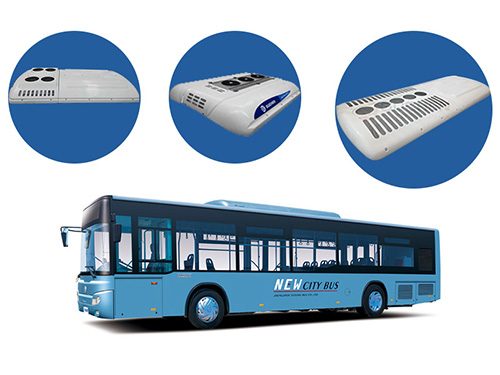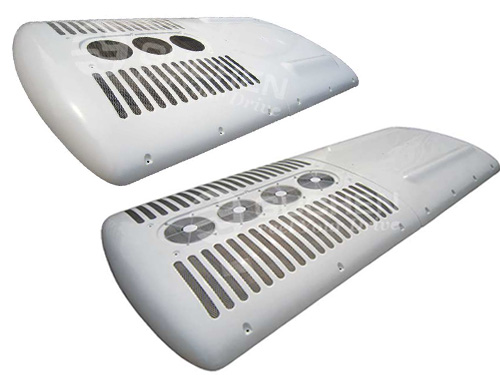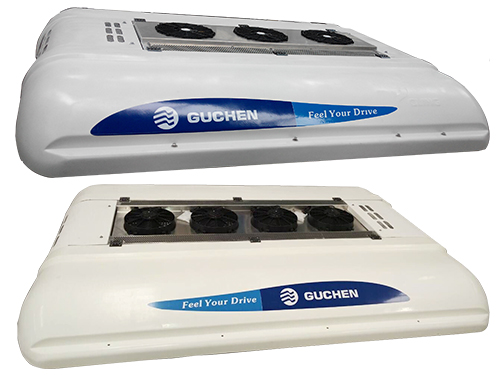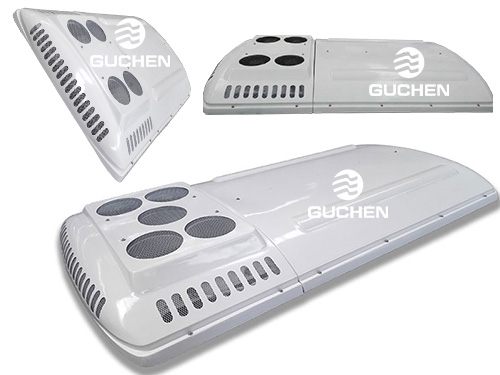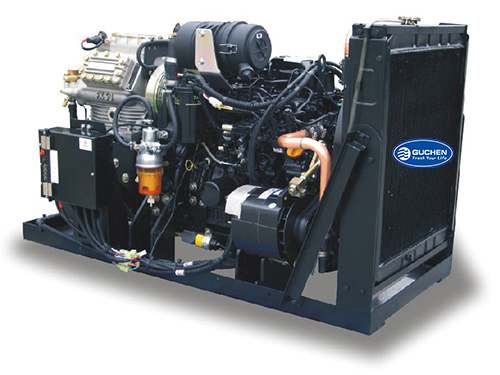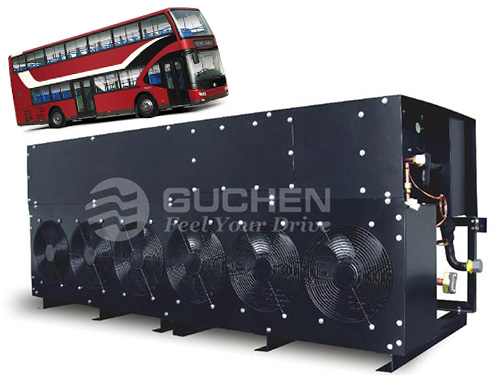Bus air conditioning plays an important role in ensuring the comfort and safety of passengers during the ride. The main function of the
bus air conditioning system is to adjust the temperature inside the bus. In addition, bus air conditioning also helps to maintain the air quality inside the bus. By circulating and filtering the air, it helps to remove dust, pollen, and other airborne particles that can cause respiratory problems or allergies. It also helps to remove odors and minimize the spread of airborne germs, viruses, and bacteria, reducing the risk of transmission of infectious diseases.
A
traditional bus air conditioner is a mechanical system that uses a compressor, condenser, evaporator, and refrigerator to cool the air inside a bus. The system works by absorbing heat from inside the bus and transferring it to the outside air, which can make the inside of the car Maintain a constant temperature.
The main difference between a
traditional bus air conditioner and an
electric bus air conditioner is in the way they are powered. A traditional bus air conditioner uses a mechanical system that relies on an engine-driven compressor and a belt-driven system to operate, while an electric bus air conditioner is powered by the bus's battery pack or an auxiliary power unit (APU) and operates on electricity.
In order to adapt to the development of the new energy era, protect the environment and use energy efficiently, the use of electric buses and electric bus air conditioners will be greater than traditional bus air conditioners.
Which models are traditional bus air conditioners suitable for?
Traditional bus air conditioners are suitable for various models and types of bus. These
air conditioning systems can be found in city and intercity buses and come in different sizes and configurations. Some common bus types that use conventional air conditioning include:
City buses: Traditional bus air conditioners are widely used in city buses operating in urban areas. These buses often have high passenger capacity and frequent stops, requiring efficient cooling systems to maintain a comfortable environment for passengers.
Intercity buses: Intercity buses that travel longer distances between cities also often use traditional air conditioning systems. These buses are specially designed for long-distance travel and provide cooling to ensure the comfort of passengers during the journey.
Coach: A coach or luxury bus, often used for long-distance travel or tourist purposes, also uses traditional air conditioning. These buses may have additional features such as individual air vents, adjustable airflow, and temperature control to improve passenger comfort.
School buses: In some areas, school buses are equipped with air conditioning systems to maintain a comfortable temperature for students commuting to and from get off work. Traditional air conditioners can be found on school buses to provide cooling during hot weather conditions.
Shuttle Bus: Shuttle buses are often used for transportation to airports, hotels, and other locations and may be equipped with traditional air conditioning systems. These buses usually carry moderate passengers and require efficient cooling for short trips.
Different bus models may have differences in the design and implementation of the
air conditioning system, but the basic principles of traditional bus air conditioning are the same.
What types of compressors are used in traditional bus air conditioners?
In
traditional bus air conditioners,
reciprocating compressors are usually used. A reciprocating compressor is a type of positive displacement compressor that operates using a piston-cylinder arrangement. They are used in a wide variety of air conditioning and refrigeration applications, including bus air conditioning systems.
Reciprocating compressors work by drawing refrigerant vapor into the cylinder during the suction stroke. The vapor is then compressed by the reciprocating motion of the piston, which increases the pressure and temperature of the refrigerant. The compressed refrigerant is then discharged from the cylinder to a condenser for further processing.
Reciprocating compressors are available in different sizes and capacities, which can be selected according to the specific cooling requirements of the passenger car. The capacity of the compressor is determined by factors such as bus size, passenger capacity and required cooling performance.
Reciprocating compressors are commonly used in traditional bus air conditioning, but other types of compressors, such as
scroll or rotary compressors, can also be found in certain bus models or in more advanced
electric air conditioning systems. These alternative compressor types offer different advantages in terms of efficiency, noise level, and reliability.
Which type of refrigerant does the bus air-conditioning compressor use?
The specific refrigerant type used in a
city bus air-conditioning compressor can vary depending on a number of factors, including regional regulations, environmental considerations, and the specific design of the air-conditioning system. However, the most commonly used refrigerants in conventional bus air conditioning include:
R134a: R134a is a hydrofluorocarbon (HFC) refrigerant that has been widely used in passenger car air conditioning systems. It is often used as a replacement for the ozone-depleting refrigerant R12 (CFC-12). R134a has good thermodynamic properties and provides efficient cooling.
R407c: R407c is another HFC refrigerant commonly used in passenger car air conditioning systems. It is a mixture of three refrigerants - R32, R125, and R134a. R407c offers a similar performance to R134a and is intended as a direct replacement for R22 (HCFC-22), which is being phased out due to its impact on the ozone layer.
R410a: R410a is a hydrofluorocarbon (HFC) refrigerant blend widely used in modern air conditioning systems, including some bus air conditioners. It is a mixture of two refrigerants - R32 and R125. R410a has a higher cooling capacity and higher energy efficiency than R134a or R407c.
How does the coach provide power support for the bus air-conditioning compressor?
Bus air conditioning compressors are typically powered by the passenger car engine or auxiliary power unit (APU).
Engine-driven compressor: In many passenger car air-conditioning systems, especially large passenger cars, the air-conditioning compressor is directly driven by the passenger car engine. A belt or pulley system connects the engine to the compressor so that it is driven by the engine's mechanical power. When the passenger car engine is running, the power it generates is transferred to the compressor, enabling it to run and providing the necessary cooling.
Auxiliary Power Unit (APU): In some cases, buses may be equipped with an auxiliary power unit (APU), specifically designed to power various onboard systems, including the air conditioning compressor. The APU is a self-contained engine or generator installed on a passenger car that operates independently of the main engine.
It is primarily used to power auxiliary systems when the main engine is not running or when additional power is required. The APU can be dedicated to powering the air conditioning compressor, keeping the passenger car at a comfortable temperature even when the main unit is turned off.
The choice between the engine-driven compressor and the APU depends on the bus design, size, and intended use. Engine-driven compressors are more common in large passenger cars, and the head unit generates enough power to drive the air conditioning system. The APU is typically used in situations where the bus requires air conditioning when idling, during breaks, or in certain operating modes when the main unit is not running.
It should be noted that the specific power support mechanism of the
air conditioning compressor may vary depending on the bus manufacturer, vehicle model, and configuration chosen by the bus operator.
How do the compressors and engines of traditional bus air conditioners work?
The compressor and engine of the traditional passenger car air conditioner work together to provide the necessary cooling for the passenger car. Let's understand how each component works:
Compressor: The compressor is responsible for compressing the refrigerant gas in the air conditioning system. In traditional passenger car air conditioners, reciprocating compressors are usually used. The operation of a reciprocating compressor involves the following steps:
A. Suction stroke: During the suction stroke, the piston moves down creating a vacuum in the cylinder. This vacuum draws low-pressure refrigerant vapor from the evaporator.
b. Compression stroke: As the piston moves upward, it compresses the refrigerant vapor, increasing its pressure and temperature. The high-pressure refrigerant gas is then discharged from the compressor.
The mechanical energy required for the compression process is provided by the reciprocating motion of a piston driven by the passenger car engine or auxiliary power unit (APU). The compressor continuously repeats the suction and compression strokes to maintain the required pressure and temperature of the refrigerant in the air conditioning system.
Engine: The bus's engine generates the power needed to drive the compressor and other on-board systems. It could be a diesel engine, a gasoline engine, or in some cases an electric motor. Engines operate by converting the chemical energy of fuel into mechanical energy.
In an engine-driven compressor setup, a belt or pulley system connects the engine to the compressor. When the bus's engine is running, it drives the compressor through this mechanical connection, which turns the compressor on and compresses the refrigerant.
In the case of an APU driven compressor, the APU is a separate engine or generator that powers the compressor independently of the bus's main engine. The APU provides the necessary mechanical energy to drive the compressor, allowing the air conditioning system to function properly even when the main unit is not running or in a specific operating mode.
The combined operation of the compressor and engine ensures that the refrigerant is compressed and circulated in the air conditioning system, facilitating the heat transfer process required to cool the interior of the passenger car. The cooled air is then distributed throughout the bus by means of blowers or fans to provide a comfortable environment for passengers.
Models of Guchen conventional bus air conditioners


